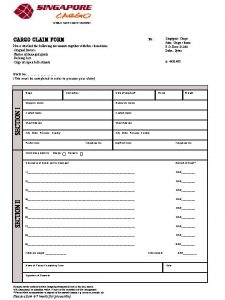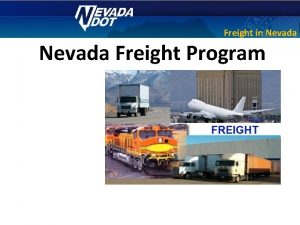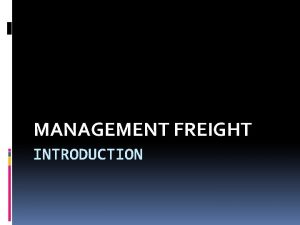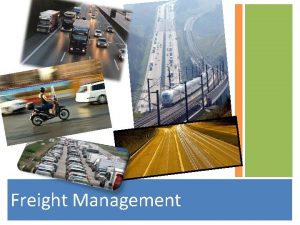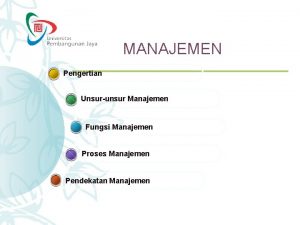Manajemen Freight 3 sks Definition wikipedia Cargo or
















- Slides: 16

Manajemen Freight 3 sks

Definition (wikipedia) • Cargo (or freight) is goods or produce transported, generally for commercial gain, by ship, aircraft, train, van or truck. • In modern times, containers are used in most intermodal long-haul cargo transport.

Another Definition • means all charges due to the Carrier for or in connection with a shipment, including any associated charges and expenses and/or any storage charges and expenses incurred by the Carrier prior to loading and/or after discharge and/or any surcharges which the Carrier may levy pursuant to clause 3. 2. . . www. poferriesfreight. com/freight/content/pages/template /_footer_terms_and_conditions. ht m • A pricing term indicating that the cost of the goods, insurance, and freight are included in the quoted price. www. usaexportimport. com/glossary. php • Goods being transported from one place to another. en. logisticsplatform. com. ua/

Another Definition • A publication containing a list of articles and the classes to which they are assigned for the purpose of applying class rates, together with governing rules and regulations. www. rlcarriers. com/glossary. asp • Any product being transported. www. yrc. com/shippers/glossary. html • Merchandise hauled by transportation lines. www. aapa-ports. org/industry/content. cfm

freight forwarder • Firm specializing in arranging storage and shipping of merchandise on behalf of its shippers. • It usually provides a full range of services including: tracking inland transportation, preparation of shipping and export documents, warehousing, booking cargo space, negotiating freight charges, freight consolidation, cargo insurance, and filing of insurance claims. • Freight forwarders usually ship under their own bills of lading or air waybills (called house bill of lading or house air waybill) and their agents or associates at the destination (overseas freight forwarders) provide document delivery, deconsolidation, and freight collection services. • Also called forwarder.

Bill • Document evidencing one party's indebtedness to another, such as an invoice. • Draft of a proposed statute (Act Of Parliament) which must be approved by both houses of the legislature and signed by the Head Of State (such as a President) to become a law. • Short name for due-bill which is a statement of money owed in securities trading. • Short name for bill of exchange, bill of lading, or treasury bill.

bill of lading (B/L) • • Document issued by a carrier, or its agent, to the shipper as a contract of carriage of goods. It is also a receipt for cargo accepted for transportation, and must be presented for taking delivery at the destination. Among other items of information, a B/L contains (1) consignor's and consignee's name, (2) names of the ports of departure and destination, (3) name of the vessel, (4) dates of departure and arrival, (5) itemized list of goods being transported with number of packages and kind of packaging, – (6) marks and numbers on the packages, – (7) weight and/or volume of the cargo, – (8) freight rate and amount. – – –

Air Waybill • Type of bill of lading that serves as a – (1) receipt of goods by an airline (carrier) and – (2) as a contract of carriage between the shipper and the carrier. It includes • (a) conditions of carriage that define (among other terms and conditions) the carrier's limits of liability and claims procedures, • (b) a description of the goods, and • (c) applicable charges. The airline industry has adopted a standard format for AWB which is used throughout the world for both domestic and international traffic. Unlike a bill of lading, an AWB is a non-negotiable instrument, does not specify on which flight the shipment will be sent, or when it will reach its destination.

Transportation • Any device used to move an item from one location to another. Common forms of transportation include planes, trains, automobiles, and other two-wheel devices such as bikes or motorcycles. • The process of shipping or moving an item from point A to point B.

Marine Cargo Types There is a wide range of marine cargoes at seaport terminals operated. The primary types are these: • Automobiles are handled at many ports, usually carried on specialist roll-on/roll-off ships. • Break bulk cargo is typically material stacked on wooden pallets and lifted into and out of the hold of a vessel by cranes on the dock or aboard the ship itself. The volume of break bulk cargo has declined dramatically worldwide as containerization has grown. A safe and secure way to secure Break bulk and freight in containers is by using Dunnage Bags. • Bulk Cargoes, such as salt, oil, tallow, and Scrap metal, are usually defined as commodities that are neither on pallets nor in containers, and which are not handled as individual pieces, the way heavy-lift and project cargoes are. Alumina, grain, gypsum, logs and wood chips, for instance, are bulk cargoes. • Containers are the largest and fastest growing cargo category at most ports worldwide. Containerized cargo includes everything from auto parts and machinery components to shoes, toys, and frozen meat and seafood. • Project cargo and heavy lift cargo may include items such as manufacturing equipment, factory components, power equipment such as generators and wind turbines, military equipment or almost any other over sized or overweight cargo too big or too heavy to fit into a container.


Air cargo • Air cargo is commonly known as air freight. There are many firms which collect freight from a shipper and deliver it to the customer such as Nightfreight or UPS. Aircraft were first used for carrying mail as cargo in 1911, but eventually manufacturers started designing aircraft for freight as well. There are many commercial aircraft suitable for carrying cargo such as the Boeing 747 and the bigger An-124, which were purpose built to be easily converted to a cargo aircraft. Such very large aircraft also employ quick loading containers known as ULDs much like containerized cargo ships. It is located in front mismo of the aircraft the triangular shaped in front. •


Freight train • Trains are capable of transporting large numbers of containers which have come off the shipping ports. T • rains are also used for the transportation of steel, wood and coal. Trains are used as they can pull a large amount and generally have a direct route to the destination. • Under the right circumstances, freight transport by rail is more economic and energy efficient than by road, especially when carried in bulk or over long distances. • The main disadvantage of rail freight is its lack of flexibility. For this reason, rail has lost much of the freight business to road transport. Rail freight is often subject to transshipment costs since it must be transferred from one mode to another in the chain; these costs may dominate and practices such as containerization aim at minimizing these. Many governments are now trying to encourage more freight onto trains, because of the environmental benefits that it would bring; rail transport is very energy efficient.


Van or Truck Cargo • There are many firms which transport all types of cargo, ranging from letters to houses to cargo containers. These firms like Parcelforce or Fed. Ex which deliver fast and sometimes same day deliverly services. A good example of road cargo is supermarket stock, as these require deliveries every day to keep the shelves stacked with goods for sale. Retailers of all kinds rely upon delivery trucks, be they full size semi trucks or smaller delivery vans. • Freight is a term used to classify the transportation of cargo and is typically a commercial process. Items are usually organized into various shipment categories before they are transported. This is dependent on several factors: – The type of item being carried, i. e. a kettle could fit into the category 'household goods'. – How large the shipment is, both in terms of item size and quantity. – How long the item for delivery will be in transit. • Shipments are typically categorized as household goods, express, parcel, and freight shipments.

















